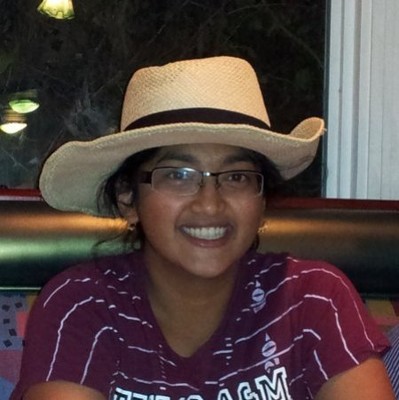
Mahima Agumbe Suresh
- Courses4
- Reviews5
- School: Texas A&M University
- Campus: College Station
- Department: Computer Science
- Email address: Join to see
- Phone: Join to see
-
Location:
College Station, TX - Dates at Texas A&M University: October 2017 - January 2020
- Office Hours: Join to see
N/A
Would take again: Yes
For Credit: Yes
0
0
Not Mandatory
Awesome
Proffessor Suresh has and immense amount of knowledge in network systems and encourages to dive deep into it. I highly recommended them!
Biography
Texas A&M University College Station - Computer Science
Resume
2010
Doctor of Philosophy (Ph.D.)
Dissertation title: A Cyber-Physical Systems approach to Water Distribution System Monitoring
Computer Science
Aggie Women in Computer Science
Texas A&M University
3.8/4
Special Topics in Cyber-Physical Systems
Introduction to AI Robotics
Computer Architecture
Special Topics in Wireless and Mobile Sysems
Programming Language Design
Distributed Algorithms and Systems
Analysis of Algorithms
Operating Systems
Introduction to Optimization
2005
B Tech
Computer Engineering
SpicMacay
\nIEEE NITK Student Chapter
\nStar Gazing Club
\nWeb Club
\nLinux Users Group
National Institute of Technology
Karnataka Surathkal
8.59/10
Society for Promotion of Indian Classical Music and Culture Amongst Youth (SPICMACAY)
Statistics
Databases
Programming
Algorithms
Linux
LaTeX
Data Structures
C++
C
Optimization
Research
Towards Optimal Monitoring of Flow-based Systems using Mobile Wireless Sensor Networks
M. Katherine Banks
Amin Rasekh
Monitoring flow-based systems (FBS) (e.g.
water distribution systems
oil and gas pipelines
the human cardiovascular system) is of paramount importance considering their economic and health impacts. FBS monitoring typically has been achieved by costly
complex
static sensors that are strategically placed. To reduce the cost of monitoring
we propose a mobile wireless sensor network (WSN) system comprised of mobile sensors (their movement aided by the inherent flow in the FBS) and static beacons that aid in locating sensors.
Towards Optimal Monitoring of Flow-based Systems using Mobile Wireless Sensor Networks
Walt Magnussen
Ana E Goulart
Security is an important concern in Voice over IP (VoIP) applications. An approach to securing the signaling
such as the Session Initiation Protocol (SIP) messages
is by using Transport Layer Security (TLS). Several studies have been done to measure the impact of using TLS on SIP. However
there have not been any tests on the use of TLS in the scenario of emergency IP-based calls
such as Next Generation 9-1-1 (NG-9-1-1) calls. We propose to demonstrate NG-9-1-1 calls over TLS
and present preliminary statistics of different call scenarios.
Experiments with SIP over TLS in an NG-9-1-1 testbed
M. Katherine Banks
Amin Rasekh
Avi Ostfeld
Lidia Smith
Mobile sensor networks for optimal leak and backflow detection and localization in municipal water networks
Mohan Kumar M. S.
Radu Stoleru
Anjana G. R
Manohar
Usha
In this paper
we propose a Cyber-Physical system (CPS) - CPWDS
for continuous monitoring of a WDS. Mobile sensors reside in the CPWDS and move with the flow of water in pipes; mobile sensors communicate with static beacons placed outside the pipes
and report sensed data; the flows in the pipes are controlled to prevent sensors from getting stuck and to ensure the sensors cover the main pipes of the WDS. We evaluate the proposed algorithms/protocols for the communication
computation and control of the CPWDS and demonstrate their performance through extensive simulations.
A cyber-physical system for continuous monitoring of Water Distribution Systems
Basem Shihada
Emily Zechman
Radu Stoleru
Acyclic flow networks
present in many infrastructures of national importance (e.g.
oil and gas and water distribution systems)
have been attracting immense research interest. Existing solutions for detecting and locating attacks against these infrastructures have been proven costly and imprecise
particularly when dealing with large-scale distribution systems. In this article
to the best of our knowledge
for the first time
we investigate how mobile sensor networks can be used for optimal event detection and localization in acyclic flow networks. We propose the idea of using sensors that move along the edges of the network and detect events (i.e.
attacks). To localize the events
sensors detect proximity to beacons
which are devices with known placement in the network. We formulate the problem of minimizing the cost of monitoring infrastructure (i.e.
minimizing the number of sensors and beacons deployed) in a predetermined zone of interest
while ensuring a degree of coverage by sensors and a required accuracy in locating events using beacons. We propose algorithms for solving the aforementioned problem and demonstrate their effectiveness with results obtained from a realistic flow network simulator.
On Event Detection and Localization in Acyclic Flow Networks
Harsha Chenji
Radu Stoleru
This paper presents the first analytical model for coexisting 802.11 and 802.15.4 networks. We derive analytically
using Markov chains
the normalized saturation throughput under coexistence. Additionally
we propose a performance tuning method that ensures QoS and a distributed Nash-equilibrium-based method that ensures fairness. We validate our model and the tuning methods using a coexistence simulator previously developed and presented by the authors. We demonstrate that our model has a low average error smaller than 10%.
On Modeling the Coexistence of 802.11 and 802.15.4 Networks for Performance Tuning
Basem Shihada
M. Katherine Banks
Radu Stoleru
Amin Rasekh
Lidia Smith
Leak and backflow detection are essential aspects of Water Distribution System (WDS) monitoring. Most existing solutions for leak/backflow detection in WDSs focus on the placement of expensive static sensors located strategically. In contrast to these
we propose a solution whereby mobile sensors (i.e.
their movement aided only by the inherent water flow in the system) detect leaks/backflow. Information about the leaks/backflow is collected from the sensors either by physically capturing them
or through wireless communication. Specifically
we propose models to maximize leak/backflow detection given a cost constraint (a limit on the number of sensors). Through extensive simulations
we demonstrate the superior performance of our proposed solution when compared with the state of the art solutions (e.g.
algorithms/protocols and analysis).
Mobile Sensor Networks for Leak and Backflow Detection in Water Distribution Systems
Implemented secure call set up using SIP protocol over TLS and HTTPs\n\nMaintained and enhanced a SIP-based VoIP emergency calling service testbed
NG-9-1-1
Sensor Control For Cyber-Physical Water Distribution Systems
Determined the system dynamics for the stochastic movement of sensors with minimal steering capability through a water distribution system\n\nDesigned a sensor control mechanism using a Linear Quadratic Regulator (LQR) to guide sensors to ensure sensing coverage
Steganography on images and audio
Developed an application to perform steganography on BMP images and WAV and AU audio files\n\nDeveloped a web interface using LAMP software bundle
Energy Efficient Data Handling with Time Synchronization in Wireless Sensor Networks
Developed a secure
energy efficient time synchronization protocol for low power wireless sensors networks\n\nImplemented and tested the protocol using GlomoSim simulator
PACMan: Prefetch-aware Cache Management for High Performance Caching
Implementation of PACMan
a recent approach towards prefetch-aware cache replacement
in last level cache in SimpleScalar by adding a L3 cache
streamer prefetcher
and DRRIP (Dynamic Re-Reference Interval Prediction) using Set Dueling Monitors to SimpleScalar\n\nProposed extension of prefetch awareness to LRU and Segmented LRU cache replacement policies
IBM's The Great Mind Challenge
Our team was among the 8 finalists of The Great Mind Challenge competition organized by IBM in 2007\n\nDeveloped a Database system on a web based application for a District Collectorate Information System
Obstacle avoidance using optical flow in Unmanned Aerial Vehicles
Obtained the time to contact for objects in the visible frame through optical flow using OpenCV libraries\n\nEnhanced raw video feeds from a Unmanned Aerial Vehicle robot to indicate time to contact and optical flow
Analysis of the co-existence of wireless technologies
Developed a Markov chain model to analyse the coexistence of WiFi and BoX-MAC
a commonly based MAC protocol for wireless sensor networks\n\nDeveloped an algorithm based on game theory concepts to tune parameters to enhance performance
A Cyber-Physical Systems Approach to Water Distribution System Monitoring
Developing algorithms for optimal event detection and localization
flow learning
MAC & group communication protocols
and flow control in Water Distribution Systems and flow-based systems in general\n\nDeveloped and maintained a C++ simulator to test the design of the Cyber Physical System
Mahima
Goldman Sachs Services Pvt Ltd
Intel Corporation
San Jose State University
Xerox Research Centre India
Texas A&M University
Indian Space Research Organization
Texas A&M University
Developed a GUI application on Visual C# and proprietary build frameworks
and integrated it with the proprietary trading database and in-house data warehouse\n\nTrained for 12 weeks in C++
Java
DB2
Sybase
design patterns
coding practices
capital markets
XML
and OOAD
Analyst
Bengaluru Area
India
Goldman Sachs Services Pvt Ltd
Bengaluru Area
India
Post Doctoral Researcher
Xerox Research Centre India
Software development for device to device connectivity and a proof of concept for Google chrome browser\n\nWorked on Intel's Common Connectivity Framework for the Chrome browser using Native Client modules and pepper API
Summer Intern
Portland
Oregon Area
Intel Corporation
College Station
Courses CSCE 181 and CSCE 481\n\nResponsible for holding office hours and grading 6 short reports
1 long report each
and attendance for over 250 students
Teaching Assistant
Texas A&M University
College Station
Designed a Cyber-Physical System (CPS) to monitor Water Distribution Systems that uses mobile sensors and static access points\n\nWorked on the design of a Markov Chain model and game theoretic technique to boost throughput by tuning the parameters of coexisting 802.11 and 802.15.4 devices\n\nMentored students undertaking research in Cyber-Physical Systems and Wireless Coexistence in the Laboratory for Embedded and Networked Sensor Systems
Graduate Assistant - Research
Texas A&M University
Bryan/College Station
Texas Area
Visiting Assistant Professor
Texas A&M University
San Francisco Bay Area
Assistant Professor
San Jose State University
Studied image and audio file formats to identify the least significant bits of information\n\nDeveloped a web-based application that performed steganography on image and audio files
Summer Intern
Bengaluru Area
India
Indian Space Research Organization
College Station
Maintained and enhanced a SIP-based VoIP emergency calling service testbed
NG-9-1-1\n\nPerformed experiments and analysed NG-9-1-1 calls over TLS
Graduate Assistant - Research
Texas A&M University
IEEE NITK Student Chapter member (Jan 2006 - May 2009)
Member
IEEE Student Member
Member
Aggie Women in Computer Science
ACM-W member
Member
ACM Student Member
English
Hindi
Kannada
National Talent Search Scholar
Scholarship offered to 1000 students at the class X level based on two written examinations and an interview
National Council of Educational Research and Training (NCERT)
Student Travel Grant
Student Travel Grant (Sponsored by NSF): ACM SenSys 2011 and CPS Week 2015
Possible Matching Profiles
The following profiles may or may not be the same professor:
- Unknown Mahima Agumbe Suresh (90% Match)
Visiting Assistant Professor
Texas A&M Engineering Experiment Station - Texas A&m Engineering Experiment Station - Unknown Mahima Agumbe Suresh (80% Match)
Visiting Assistant Professor
Texas A&M University - Texas A&m University



